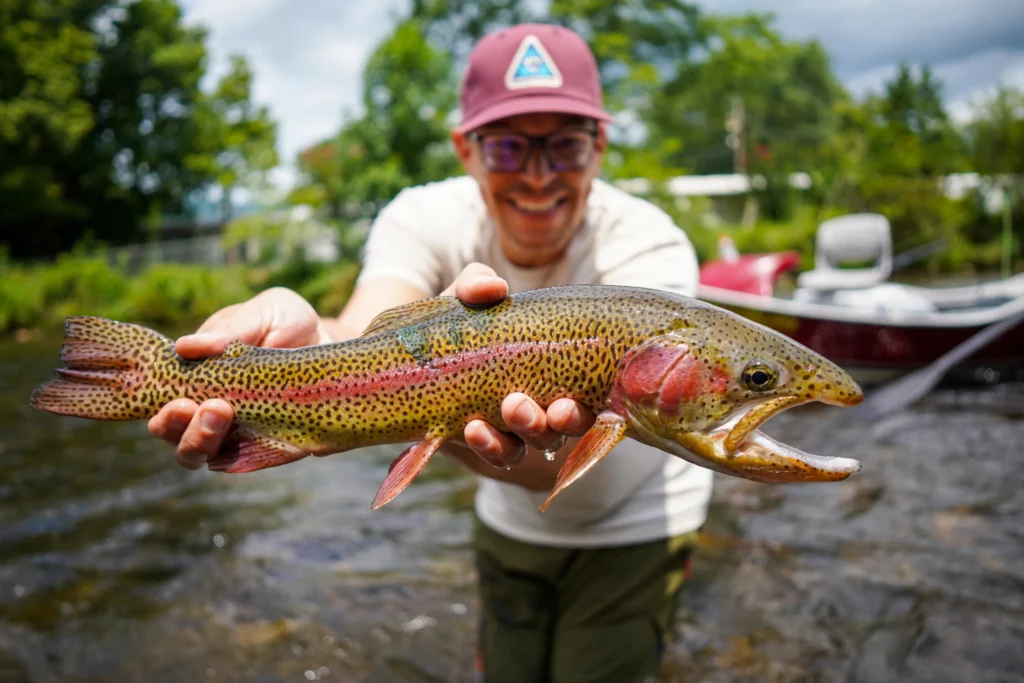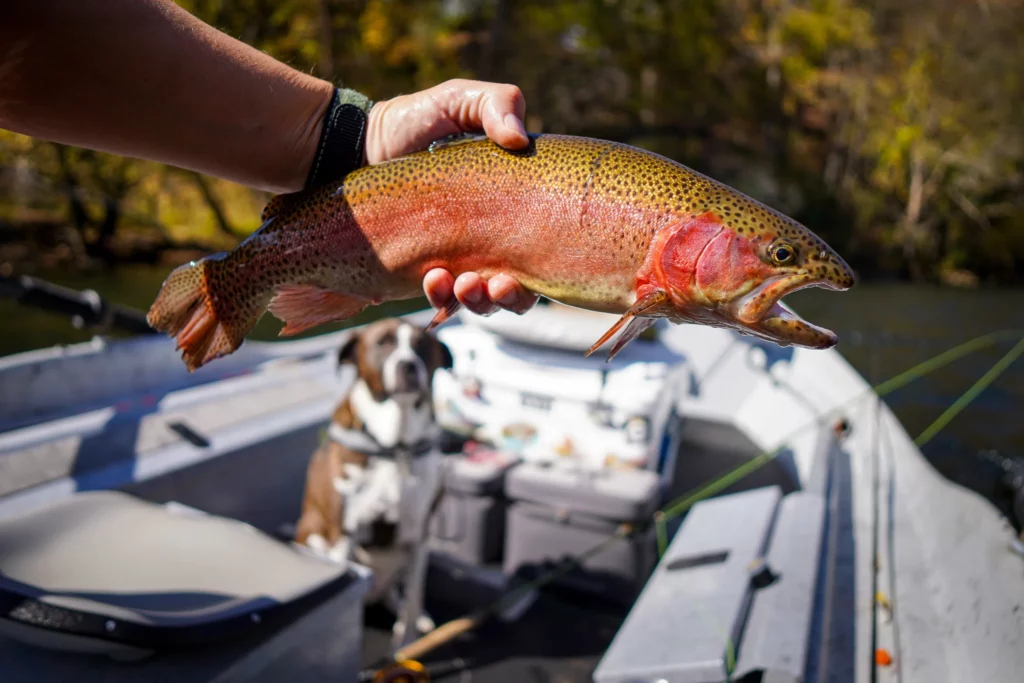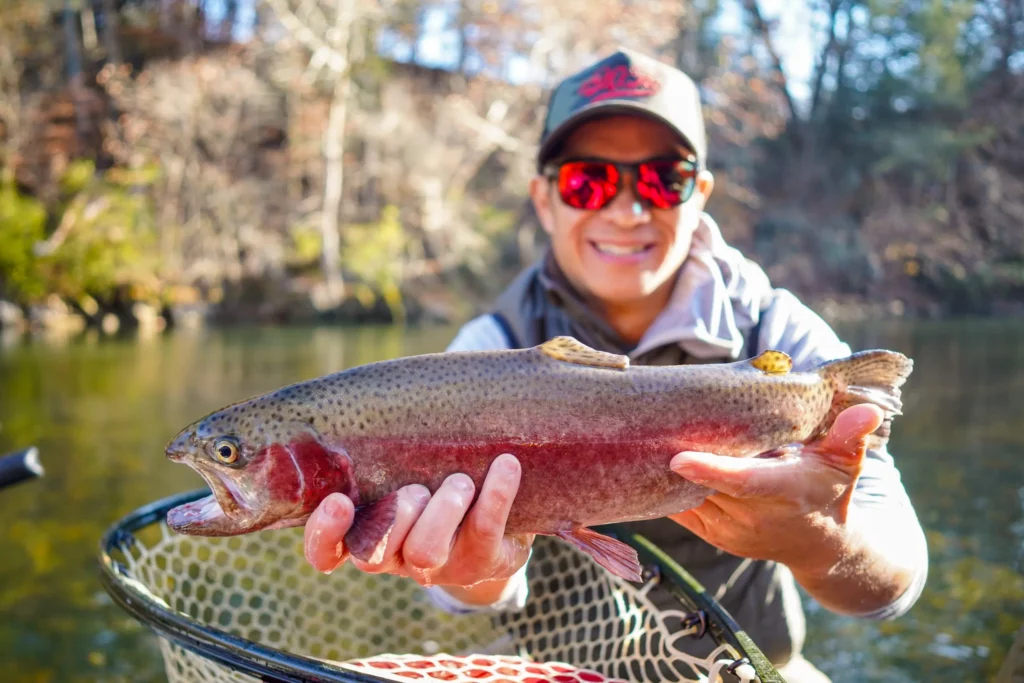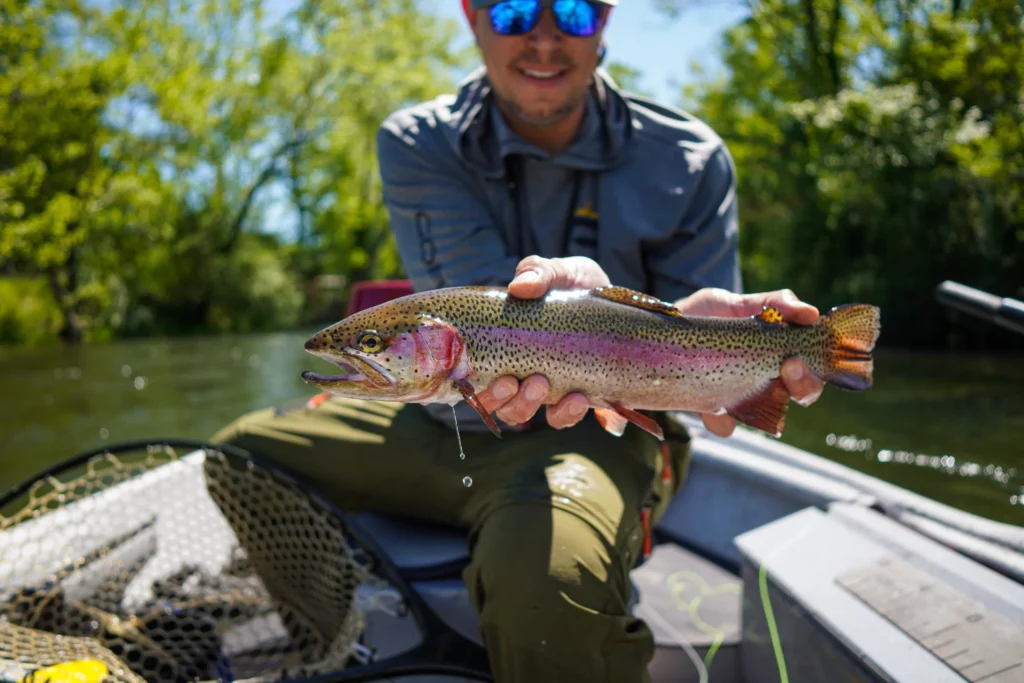South Holston River Trout Fishing: A Guide for Anglers
Welcome to the enchanting world of the South Holston River, a true paradise for trout anglers. Nestled in the scenic landscapes of Tennessee, this river has carved its reputation as one of the premier destinations for trout fishing in the United States. Renowned for its abundant and sizeable trout population, the South Holston offers an unparalleled fishing experience that attracts both novice and seasoned fly fishermen year-round.
The river’s unique charm lies not only in its bountiful trout but also in its diverse aquatic environments. From gentle, meandering flows to more challenging, rapid sections, South Holston River provides a variety of settings for different fishing techniques. The river is predominantly known for its healthy populations of brown and rainbow trout, offering anglers a chance to test their skills against different species.

What truly sets the South Holston apart is its consistent aquatic insect hatches, making it a haven for fly fishermen. The river boasts an impressive array of insects, including mayflies, caddisflies, and midges, providing a rich food source for the trout and making fly selection an exciting and crucial part of the fishing experience. The renowned Sulphur hatch, a spectacle in itself, draws anglers from far and wide, eager to witness and partake in this natural event.
Situated in a picturesque valley, the river’s surroundings add to the overall experience, with lush greenery and the serene backdrop of the Appalachian Mountains. Whether you’re a fly fishing enthusiast or simply someone who appreciates the beauty of nature, South Holston River promises an unforgettable adventure. Join us as we dive deeper into this angler’s paradise, exploring the best techniques, gear, and spots to make the most of your fishing journey on the South Holston River.

Understanding South Holston River
The South Holston River, flowing through the heart of Tennessee, presents a varied and enchanting landscape for anglers. Originating from the South Holston Dam, it winds through stunning scenery, offering a diverse range of fishing environments. The river features deep pools, swift runs, and gentler sections, each with its own unique fishing opportunities. Notable fishing spots include the Weir Dam, Osceola Island, and areas downstream of Emmett Bridge, each acclaimed for their rich trout populations and picturesque settings.
Geography and Water Conditions
The river’s water conditions are integral to its appeal. Benefitting from a bottom-release dam, the South Holston maintains a consistent temperature and clarity, creating ideal conditions for trout. The clear, cold waters demand skillful, subtle approaches, as the trout here can be particularly discerning.
Trout Species in South Holston River
The South Holston River is a haven for trout enthusiasts, boasting a rich variety of species. Dominant among these are the brown trout, known for their size and strength, with many exceeding 20 inches. Rainbow trout also thrive here, offering a vibrant and spirited fishing experience. Seasonal changes significantly influence trout behavior and distribution in the river. Spring and fall witness heightened activity with more aggressive feeding patterns, while summer and winter challenge anglers with more subdued trout activity, requiring refined strategies.
Each season on the South Holston River brings its distinct flavor and fishing challenges, making it a year-round destination for anglers. Whether engaging in dry fly fishing during the active spring or navigating the deeper waters with nymphs in the colder months, understanding these seasonal patterns is crucial for a fulfilling fishing experience.
Essential Gear for South Holston River Trout Fishing
Having the right gear for a day on the South Holston River is essential. Depending on the type of fishing you’re trying to do, will depend on the best gear for that situation. Afterall, dry fly fishing requires a vastly different rig than streamer fishing. Below you will find some of our recommendations.
Fly Fishing Rods and Reels
When gearing up for a fruitful day on the South Holston River, choosing the right rod and reel setup is crucial. Given the river’s varied landscape, a versatile approach works best. A 9-foot rod for a 4 or 5-weight line is ideal for most situations you’ll encounter here. This setup offers enough length for effective casting in wider sections and sufficient backbone for handling the larger browns, while still being delicate enough for the lighter takes of rainbows.
For the reel, look for something with a smooth drag system to protect the lighter tippets often used in South Holston. A reel that balances well with your rod, ensuring comfort during long days on the water, will enhance your fishing experience.
Flies and Tackle
The South Holston River’s insect life is abundant, making fly selection both exciting and critical. A good starting point is to have a variety of nymphs, dry flies, and streamers. Nymphs like the Pheasant Tail or the Copper John in sizes 16 to 22 can be particularly effective. For dry flies, patterns such as the Blue Winged Olive or Sulphur Dun, depending on the season, are essential. Sizes 18 to 24 work well for these.
Streamers also have their place in your arsenal, especially when targeting larger brown trout. Patterns like Woolly Buggers or Zonkers in natural colors can be effective, especially in deeper pools or during higher water conditions.
Pay attention to the current hatches when selecting fly size and color. The South Holston is known for its Sulphur and Blue Winged Olive hatches, so matching these patterns can lead to a successful day. Observing the river’s insect activity and trout behavior upon arrival will guide your initial fly choice and throughout your fishing session. Remember, sometimes the subtlest variation in size or color can make all the difference between a good day and a great one on the South Holston.
Fly Fishing Techniques for South Holston River
Embarking on a fly fishing adventure in the South Holston River calls for a blend of skill, patience, and knowledge of key fishing techniques. This renowned river, with its diverse currents and rich aquatic life, presents both challenges and opportunities for the discerning angler. Whether you’re navigating its serene slow-moving sections or tackling the more dynamic riffles, mastering the art of fly fishing here is both rewarding and exhilarating. In this guide, we’ll delve into essential fly fishing techniques tailored for the South Holston River, covering casting methods, line management, and the critical skill of reading the water. These techniques are designed to enhance your experience and success rate, helping you to not only enjoy the beauty of the river but also to connect with its vibrant trout population.

Casting Techniques
Mastering casting techniques is vital for success in the varied currents of the South Holston River. In slower, clear water, a delicate presentation is key, using a longer leader and a soft, accurate cast to avoid spooking the trout. Practice casting upstream and allowing your fly to drift naturally with the current, minimizing drag.
In faster, riffled sections, a more robust approach may be required. Here, shorter, more powerful casts ensure your fly reaches the desired depth quickly. Learning to adjust your casting technique based on the water you’re targeting is crucial. Also, be prepared to adjust the length and weight of your line to suit the conditions of the day.
Mending and Line Management
Effective mending and line management are critical for presenting your fly in a way that mimics natural insect movement. Proper mending, which involves lifting and moving the line after the cast, helps prevent unnatural drag on the fly. This skill is especially important in the South Holston River, where discerning trout are often put off by poorly presented flies.
Develop a habit of observing the current and anticipate how it will affect your line. Mend early and often, always striving for a drag-free drift. Remember, the goal is to make your fly the only thing the trout notices, not the line attached to it.
Reading the Water
Reading the water is an art that can significantly increase your chances of finding trout. Look for seams where fast and slow currents meet, as trout often feed in these areas. Pay attention to underwater structures like rocks and fallen trees, as these provide excellent hiding spots for trout. Eddies and pools are also key areas, especially after a hatch when trout might be actively feeding.
Observing insect activity on the water’s surface can give clues about where trout might be feeding. Additionally, learning to read the subtle signs of a feeding trout, such as the flash of a fin or a slight ripple on the water’s surface, can guide you to the most promising spots. With practice, reading the water becomes an instinctive part of your fly fishing experience on the South Holston River.

Best Times to Fish
The South Holston River, a tailwater river famed for its excellent water conditions, offers a unique year-round fishing opportunity. Unlike many other rivers that may have restricted fishing seasons due to various environmental factors, the South Holston maintains a consistent flow and temperature, thanks to the regulated releases from the South Holston Dam. This stability not only supports a rich and diverse trout population but also allows anglers to enjoy fly fishing across all seasons. Each season brings its own set of characteristics and challenges, making every visit to the river a new and exciting experience.
Seasonal Considerations
Spring is a time of renewal and vigorous trout activity. As the water warms, trout become more active, feeding on the increasing number of hatches. This season is often marked by prolific hatches of Blue Winged Olives and Sulphurs, making it a favorite among fly fishers.
Summer brings longer days and warmer waters, which can sometimes slow trout activity during midday. Early mornings and late evenings during this period can be particularly rewarding, especially when terrestrials and caddisflies are most active.
Fall is another prime time for fishing in the South Holston, as cooler temperatures revive trout activity. Browns and rainbows aggressively feed in preparation for winter, responding well to streamers and nymphs.
Winter, while quieter, can still provide a serene and productive fishing experience. Midges dominate the hatches during this season, and trout, although less active, can be caught with patience and the right tactics.
Hatch Calendar
January to February: Midges (sizes 20-26), Winter Stoneflies.
March to April: Blue Winged Olives (sizes 18-22), Caddis (sizes 14-16).
May to June: Sulphurs (sizes 16-18), Caddis.
July to August: Terrestrials (beetles, ants, sizes 14-18), Caddis, Tricos.
September to October: Blue Winged Olives, Caddis, Terrestrials.
November to December: Midges, Blue Winged Olives.
This calendar provides a general guideline, but local conditions and yearly variations can influence hatch timings. Being adaptable and prepared with a variety of flies to match these hatches is key to making the most of your time on the South Holston River.
Local Regulations and Conservation
Fishing the South Holston River is not only a pursuit of recreation but also a responsibility towards conservation. Understanding and adhering to local regulations is essential for maintaining the river’s health and ensuring sustainable fishing for future generations. Additionally, being aware of and participating in conservation efforts plays a crucial role in preserving this natural treasure.
Fishing Regulations
The South Holston River, managed for trophy trout fishing, has specific regulations to protect its fish population. Anglers are required to follow catch-and-release practices in certain designated sections of the river, particularly around the dam and designated trophy sections. In other areas, there are limits on the number of fish that can be kept, typically with a minimum size requirement to ensure young, growing trout are released. Additionally, the use of only artificial flies or lures is mandated in some stretches, prohibiting the use of baitfish or scented artificial baits. It’s crucial for anglers to stay updated with these regulations as they can vary annually or seasonally.
Conservation Efforts
Conservation practices in the South Holston River area include habitat restoration, pollution control, and educational outreach programs. Local fly fishing clubs and environmental groups often conduct river clean-ups and habitat improvement projects. Anglers can contribute by practicing ethical fishing, participating in local conservation events, and spreading awareness about the importance of preserving the river’s ecosystem. By respecting the river and its inhabitants, anglers can play a pivotal role in maintaining the South Holston as a premier fly fishing destination.
Additional Tips for a Successful Trip
Safety and Etiquette
Safety and etiquette are paramount for a fulfilling and responsible fly fishing experience on the South Holston River. Always be sure to check the local generation schedule before heading out for a day of wading. When wading in deeper sections or during higher water levels, pay attention to the currents, as currents can be unpredictable. Equipping yourself with a wading staff can also provide extra stability. Be mindful of the weather conditions; sudden changes can impact river levels and currents.

Respecting other anglers is crucial. Maintain a courteous distance, avoid crowding a spot where another angler is already fishing, and if you need to pass by, do so quietly and with minimal water disturbance. Practicing catch-and-release with care and respect for the fish is not just ethical but essential for conservation. Handle fish gently and keep them in water as much as possible.
Local Amenities
The area surrounding South Holston River boasts a range of amenities to enhance your fishing trip. There are numerous lodging options, from cozy cabins to more luxurious accommodations, catering to all preferences and budgets. For a more well-rounded experience, our guides are invaluable. They offer not just expertise and knowledge of the river’s hotspots but also insights into current conditions and hatches. Fly shops in the vicinity are well-stocked with gear and local fly patterns and are a great resource for up-to-date information on river conditions and fishing reports.
That’s A Wrap
The South Holston River offers a rich and diverse fly fishing experience, suitable for anglers of all skill levels. Its varied geography, consistent water conditions, and abundant trout population make it a standout destination. Whether you’re casting dry flies during a Sulphur hatch in spring or navigating nymphs in the deeper runs during winter, the river presents challenges and rewards in every season.
Remember, the key to a successful trip lies in preparation and respect – respect for the regulations, other anglers, and the environment. With the right approach and mindset, the South Holston River is not just a fishing location but a journey into the heart of fly fishing. We encourage you to immerse yourself in this unique experience, where each cast brings a new opportunity and each visit leaves lasting memories. Whether you’re a seasoned fly fisherman or just starting out, the South Holston River awaits, ready to offer its bountiful and beautiful trout fishing experiences.
